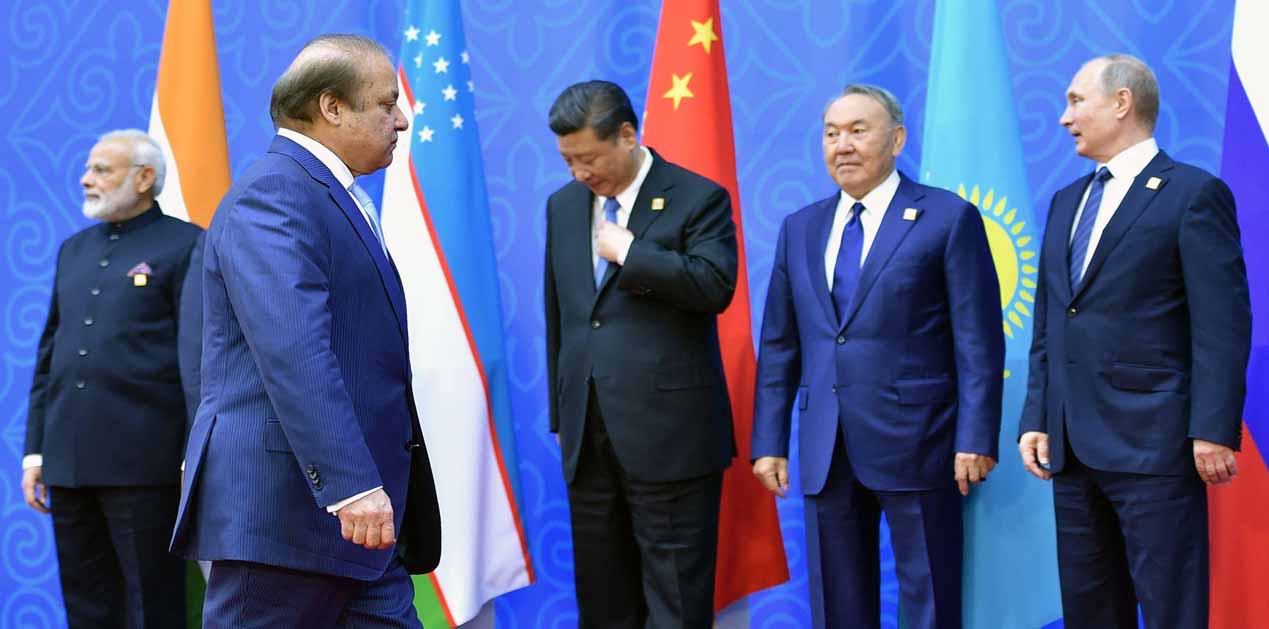After being an observer in the Shanghai Cooperation Organization (SCO) since 2005, India finally gained entry to the multilateral grouping during the Astana Summit held in June. India had applied for the full membership in 2014 after weighing very judicially the opportunities and challenges that might be presented to it after its accession to the SCO. Eventually, it was decided that India’s interests would be better served by joining the multilateral platform rather than staying out of it.
There were some reports that indicated that for giving its approval for India’s membership China wanted a quid pro quo in the shape of China being allowed entry as a full member of South Asia Association for Regional Cooperation (SAARC). It is believed that such a bargain was firmly rejected by the Indian interlocutors. It is quite evident that if China were allowed to become a full-fledged member of SAARC it would have hijacked the narrative and India’s primacy and role would have been considerably curtailed.
Undoubtedly, the SCO has evolved over the years as a very significant regional organization for forging cooperation amongst its members in diverse fields. With both India and Pakistan becoming members the profile of SCO has been further enhanced as the group now represents closer to half the humanity of the globe and 23 percent of the world’s GDP. Besides the Central Asian Republics (less Turkmenistan) it brings together three major players in Asia- Russia, China and India on a shared platform.
India is also part of some other ongoing multilateral arrangements with Russia and China in the shape of Russia-India-China (RIC) forum, Brazil-Russia-India-China-South Africa (BRICS) and G-20. The SCO will provide another platform for regular interaction Russia, China, India and other members to discuss mutual concerns, interests and find solutions for moving forward on cooperative endeavours. There is also a hope, at least on part of India that the promise of good relationship between India and China that had surfaced after exhibition of good chemistry between PM Modi and President Xi Jinping’s meeting in September 2014 and that had faded away last year due to differences on approaches to terrorism and India’s accession to Nuclear Suppliers group (NSG) might now see an uptick. On the other hand, there have been some apprehensions on the part of CARs and others that both the new members will bring their perennial conflict and hostility to the SCO platform. However, there are others who feel that the SCO membership could have a moderating effect.
Further, there is also a possibility that major powers like Russia and China might be tempted to mediate between the India and Pakistan. But such a step would not be welcome by India as New Delhi’s policy on the issue has been to resolve the India-Pakistan issues bilaterally i.e. without the intervention of any third party. Pakistan would be more inclined to bring up the bilateral issues directly or indirectly. This kind of propensity on the part of Pakistan needs to be discouraged by the other SCO members and in any case, the SCO charter does not allow bilateral problems to be aired on the multilateral platform.
The regular top leadership and ministerial meetings around the SCO implies that both Indian and Pakistani officials at a senior level from Prime Minister and head of state meetings to Health Ministers, Foreign Ministers and Interior Minister Meetings would have the opportunity to meet each other at least once a year. This will provide another platform where the two countries would have an opportunity to interact. The Ufa joint statement issued in July 2015 by India and Pakistan on the side-lines of the SCO was a positive development. However, it can also be said that Pakistan would be tempted to raise the bilateral issues as has been its wont in other multilateral platforms. On the other hand, this time there was no meeting requested by the either side i.e. India and Pakistan on the side-lines of the Astana Summit (unlike the Ufa Summit where both PM’s met) which could be ascribed to prevailing chill between the two countries. Interestingly, there was no formal meeting between President Xi Jinping and Pakistan’s PM on the side-lines of the meeting. Though there were some informal meetings and exchange of pleasantries between Xi and Sharif as also between Modi and Sharif.
However, the bilateral meeting between PM Modi and President Xi can be said to be successful especially in view of the recent strains that had developed in the relationship. Both sides acknowledged the fact that differences should not become disputes and if handled well, could even be opportunities. Also both leaders discussed economic cooperation, trade, investment and connectivity issues, establishment of industrial parks, cooperation in railways. Discussions also revolved around security and defence issues including counter-terrorism cooperation, security cooperation and defence exchanges. Apparently, the Asian Infrastructure Investment Bank and the BCIM Corridor came up for discussion. Thus, even while India objects to China Pakistan Economic Corridor (CPEC) it is not against the principle of connectivity. PM Modi also mentioned that both sides should ‘respect each other’s core interests’ which was a pointer towards India’s objections to China’s flagship project of CPEC through Indian territory occupied by Pakistan. Thus, the SCO would become an additional platform between India and China for regular exchange of views on a wide range of issues in the SCO from investment and connectivity to joint counter-terrorism exercises both on multilateral and bilateral basis.
Insofar as the relationship with CARs is concerned, its potential remains underexploited even while India considers them as part of India’s extended neighbourhood and strategically and economically significant for forging closer ties. These countries also view India as a benign balancer in the ongoing power play in the region. In addition, Indian soft power already has considerable influence in Central Asia. The SCO will provide a good forum to expand on issues such as economy, trade, connectivity and counter terrorism cooperation which are key objectives of India’s policy in this region. This approach also rhymes very well with multi-vector policies of Central Asian countries. Central Asia’s desire for diversifying hydro-power and energy export routes would correspond with India's quest for diversifying imports. India has been keen to invest in setting up downstream production facilities, instead of exporting raw materials out of the region through expensive pipelines. The membership of SCO will likely provide greater accessibility to gas and oilfields in the region.
India has been keen to improve its connectivity to CARs; India has been seeking cooperation of Iran and SCO members in achieving the aims and objectives of its ‘Connect Central Asia’ policy that was set in motion in June 2012. India is now expected to be in a better position to realize the objectives of the policy. Improving connectivity with CARs has been one of the cherished objectives of New Delhi’s policies. India, Russia and Iran are also founding members of International North South Transport Corridor (INSTC) which has been in works for quite some time and which seeks to connect India to Central Asia through Iran and beyond to Russia and Europe. Moreover, India is in the process of joining Ashgabat Agreement which the Indian government approved last year; the agreement provides for a transit corridor across Central Asia and the Middle East through linkages between Kazakhstan, Uzbekistan, Turkmenistan and Iran before reaching the Persian Gulf and into Oman. This will facilitate India's trade with Central Asia and the Eurasian region and it builds upon the INSTC. With Russia as a member and Iran as an observer there is a possibility of cooperation with China and other SCO members to support connectivity projects and the development of INSTC.
Counter terrorism is another area where cooperation between the members has assumed greater importance given the evolving situation in the middle-east and Afghanistan. In recent months Afghanistan has seen a downturn in security environment particularly so in Northern Afghanistan. More over there have been a series of attacks in Kabul and elsewhere in Afghanistan by the Taliban. It is expected that engagement with the SCO countries will provide higher degree of clarity and coordination of policies on this important country which has implications for regional security. On the other hand, there are some divergences in Russia, China and Pakistan’s approaches to peace and reconciliation in Afghanistan. While the three recognise the Taliban as a political force and favour power sharing with them; India (and the current Afghanistan government) views them as radicalized and violent extremists little different from the ISIS. The Taliban in its years of power from 1996 to 2001 exactly behaved like what ISIS has been doing in the middle-east. SCO platform would provide an opportunity to the members to coordinate and configure their approaches on the regional security issues including Afghanistan.
India’s participation in SCOs Tashkent based Regional Counter-terrorism Structure (RCTS) is likely to increase levels of intelligence sharing, as well as help the others develop counter-terrorism strategies based on India’s long experience of it. The SCO and the UN secretariats have also signed a joint declaration on cooperation on countering international terrorism in 2010 in Tashkent which form the basis for interaction between the two organizations. Thus mutual exchanges on counter terrorism issues would be beneficial for all the stakeholders.
At times SCO has been referred to as ‘NATO of the East’ assuming that it would become a military grouping. However, India will not favour SCO if it moves towards becoming a military block like NATO or the Central Security Treaty Organization (CSTO). SCO does hold joint military exercises regularly, but they are designed to be counter-terrorism exercises where observer countries are invited to send observers off and on and members are expected to participate with troops and equipment. The SCO joint terrorism exercises have been held regularly under the rubric of Peace Mission since 2005. The last such exercise tiled “Peace Mission-2016” was held in Kyrgyzstan where in militaries of SCO members participated. Now India and Pakistan would be invited to take part in such exercises. This should not pose much problems for either India or Pakistan as both armed forces have been operating together earlier in UN Peace Keeping Operations. This would further give opportunity to Indian and Pakistan militaries to interact in a cooperative manner.
Overall, India’s membership of SCO is a positive development and New Delhi needs to take advantage of the same by being proactive on the platform. India also needs to enhance its economic relationship with CARs which has been far below the potential. Connectivity woes also need to be addressed through fast implementation of projects and by pushing several existing joint projects. Mutual complementarities of connectivity projects in the region also need to be explored.
Image Source: http://timesofindia.indiatimes.com











Post new comment